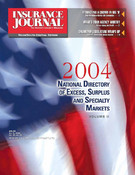In the opinion of one major industry player, The Sarbanes-Oxley Act of 2002 set in place “a mad rush to save the world from bad management,” a misguided and costly strategy that will fall victim to its unintended consequences, which include “putting everybody on edge,” engendering a fear to take risk, and, ultimately, stifling innovation.
However well-intended, the measure is “setting a bad tone” said Robert H. Benmosche, chairman, president and CEO of MetLife, during a CEO panel session on “Structuring for Success in the Insurance Industry” during Standard & Poor’s recent insurance seminar in New York City.
“It’s been real fun,” Benmosche shot back to a question on the impact of the law, evoking laughter from the audience. “We’ve really enjoyed it.”
In the wake of Enron and other high-profile business scandals, Sarbanes-Oxley introduced significant changes to financial practice and corporate governance regulation, including stringent new rules designed “to protect investors by improving the accuracy and reliability of corporate disclosures made pursuant to the securities laws.”
Benmosche was one of four industry CEOs to participate in the panel. The others were Jay S. Fishman, chairman, president and CEO of St. Paul Travelers; Edmund F. Kelly, chairman, president and CEO of Liberty Mutual; and Seymour Sternberg, chairman and CEO of New York Life.
“The pendulum,” argued Sternberg, “has swung too far” under Sarbanes-Oxley. “We’re so concerned with independence, we forget that the most important thing is effectiveness. When we change your auditors every two years, you optimize and maximize the independence aspect of it, but the effectiveness aspect is minimized, and effective auditors are just as important as independent auditors,” he maintained. “We have to recognize we have a multi-dimensional problem.”
Fishman said the Act is a good example of the caution to be careful of what you wish for. His company recently filed a 106-page-long disclosure statement under the Act. Still, he said enhanced quality controls are a better thing. “We’re in the early stages of working it out,” he said. “Transparency is a good thing. We’re heading in the right direction.
Liberty Mutual’s Kelly said politicians and journalists have a naïve take on the problem. As an example, he pointed to a recent article in the Sunday magazine of The New York Times in which an Enron whistleblower, a former department manager, is cited as an expert, a consultant in fact, in corporate governance. This, he said, reflects “a fundamental misunderstanding” of the issue.
Reinsurers warned
Another panel warned that U.S. reinsurers are in peril of repeating the mistakes of history by sacrificing profitability. With prices beginning to level off after a three-year upward surge, they said, managements must resist the temptation to pursue market share at the expense of bottom-line results.
Commented Al J. Beer, executive vice president of American Re Corp., “We have to get out of our cyclical behavior.” He referred to inadequate reserves for policies written in the late 1990s, when pricing was weak. The reinsurance industry has “a long way to go to convince ourselves and our employees that we can be profitable,” he said.
Laline Carvalho, an S&P reinsurance analyst, called the sector’s 6.5 percent ROR in 2003 “a fairly disappointing number, considering we’re at the top of the hard market.” Over the past 10 years, she said, the average ROR has been a meager 2.5 percent. Although she has seen a change in management philosophy in the past few years towards “a bottom-line focus rather than a top-line one,” she questioned whether that discipline will be maintained and “whether the industry can reverse its history of underperformance.”
Participants respond
In other news from the seminar, two-thirds of insurance executives and analysts responding to a S&P survey said the recent mergers of St. Paul/Travelers and John Hancock/Manulife suggest heightened industry consolidation activity.
Some 71 percent of respondents surveyed said the debt and equity markets reward stock insurance companies for their ability to acquire other companies.
For mutual companies, 59 percent of the respondents said they should be subject to a “mirror Sarbanes-Oxley Act,” as is being considered by the National Association of Insurance Commissioners.
Asked which presidential candidate would be more positive for the insurance industry, respondents chose George W. Bush 78 percent to 22 percent over John Kerry.
Thirty-three percent of those surveyed named increasing price competition as the issue that most concerned them.
Approximately 100 executives and analysts responded to the S&P survey. More than 500 attended the two-day seminar.
Topics New York Reinsurance Market
Was this article valuable?
Here are more articles you may enjoy.


 AIG’s Zaffino to Step Down as CEO as Aon’s Andersen Steps In
AIG’s Zaffino to Step Down as CEO as Aon’s Andersen Steps In  ’60 Minutes’ Homeowners Ask Court to Force DFS to Divulge Heritage Probe Info
’60 Minutes’ Homeowners Ask Court to Force DFS to Divulge Heritage Probe Info  10 Highest Class-Action Settlements in 2025 Eclipsed $70B Total: Duane Morris
10 Highest Class-Action Settlements in 2025 Eclipsed $70B Total: Duane Morris  Disney Worker Injured Trying to Stop Runaway Boulder at Indiana Jones Show
Disney Worker Injured Trying to Stop Runaway Boulder at Indiana Jones Show 


